Top Balance Boards For Standing Desks – The Experts Review
Like most reviews sites, our editorial staff and laboratory testing expenses are partially offset by earning small commissions (at no cost to you) when you purchase something through those links. Learn More

Just What Makes A Balance Board Great For Using With A Standing Desk?
A balance board generally consists of a flat standing surface with some element below to make the surface unstable. By adding motion underfoot you can boost your metabolism while strengthening your core muscles and improving your posture. And, as the name implies, improve your overall balance. It’s a great way to add some motion into your static position at a standing desk.
This is an extension of one of our favorite mantras: Your best position is your next one. Just like sitting all day is bad for your health, standing in a stationary position for prolonged periods of time can be bad too. A balance board helps you work around that by adding some dynamic movement to your static standing posture.
What Differentiates Any One Standing Desk Balance Board From All The Others?
Because balance boards are mostly cheap to make and easy to sell, there are endless variations on the theme. A simple web or Amazon search will bring up literally hundreds of options and all of them are about the same, with a few exceptions that you can find below in our reviews. It’s important to note that most of the balance boards sold today are not designed for use in front of a standing desk, and will be too disruptive to get any real work done.
There are countless books written by exercise physiologists on how to use balance boards. Again, none of these books talk about how to use them in front of a standing desk. We’ve even put together a list of our favorite balance board exercises. This is why you’re reading this primer. We’ve been researching and writing specifically about standing desk balance boards for years and reviewed just about every product in the category.
Balance boards generally differentiate from each other in price, quality of materials, aesthetics, and above all, the nature of the instability-inducing mechanism, i.e. whether they use a ball, a rolling peg, a cushion pad, an inverted dome or some other mechanism underneath the plank of wood.
Different types of balance boards are best for different activities. The best type for you depends on your skill level and how you want to use it. We generally break them into four categories:
Rocker board – A rocker board typically has a flat top surface with a semicircle base. This allows for a great amount of tilt, but limits movement to one plane: forward and backward. (See our expert reviews of the Top-Rated Rocker Boards.)
Wobble board – A wobble board typically is circular with one centered item on the base to allow for a great deal of movement in all directions, making it more challenging than a rocker board. (See our expert reviews of the Top-Rated Wobble Boards.)
Balance trainer – A balance trainer is the most challenging type of balance board. It typically is a flat top surface that rests on a separate balancing device, like a cylinder (though many that we’ve reviewed come with a wobble cushion to ease the learning curve). These are also called roller boards. (See our expert reviews of the Top-Rated Balance Trainers.)
Ergonomic balance board – This type of balance board is clearly the best when it comes to working at a standing desk because it allows for a great deal of movement without distracting the user’s focus, and remains inherently stable if the user needs to pause for concentration. It is the user that causes the board to move, as opposed to inherent instability causing the user to pay constant attention to staying balanced. (See our iMovR Gymba review as an example of this kind of board.)
You’ll find the boards in this roundup ranked by how useful they are while working at a standing desk.
What Makes A Particular Standing Desk Balance Board a Good Ergonomic Choice?
In this round-up of the balance board reviews that we’ve conducted over the past several years, we focus first and foremost on the new breed that is being marketed explicitly to standing desk users. With the booming adoption of adjustable-height desks, there’s an increasingly large contingent of users that want to add more motion to their unseated work time but aren’t ready to move up to a full treadmill desk yet, whether for lack of budget, floor space, permission or some other reason.

In our rating system, we indicate our assessment of how easy it is to type at a workstation while standing on one of these balance boards as its “ergonomic” score because that’s what our readers are generally interested in knowing. Only a handful of the boards we’ve reviewed can practically be used while typing, so this score is the one many potential buyers will want to pay the most attention to. Highly stable boards like the Gymba get a top score (out of 5 stars) for ergonomics because you can use them with zero degradation of your typing proficiency.
Younger and more athletic users tend to look to balance boards as a way to stay agile for snowboarding, skateboarding or other sports they partake in when away from their desks. For older and less athletic users, balance boards are often looked at as a way to prevent the onset of muscle, tendon and joint stiffness, avert the development of varicose veins from blood pooling in the calves, or simply as a way to bring relief from general soreness and fatigue in the legs, feet and lower back after prolonged periods of standing.
For all users, spending time on any balance board will empirically improve your balance. This works by stimulating the proprioceptor neurons in your bone joints that signal your brain where your physical body is positioned in 3D space. This is a great anti-aging strategy as we spend less time running around on variable terrain and arguably too much time standing and walking on perfectly flat floors, often in shoes, and thus we associate a loss of balance as a natural consequence of getting older. As studies have shown (and popularized by the book Born To Run), losing our balance and breaking our hips as we progress into the geriatric years is not predestined. There are things we can do to mitigate balance degradation, and using a good ergonomic balance board at your standing desk may be the very simplest and easiest of them.
Using a premium-quality standing desk mat made of 100% polyurethane will do the same, but obviously to a lesser degree. We always recommend pairing the two accessories so that you can use a mat when you really need to be static (such as when doing delicate mouse work) and a board when you feel the need to take a break from static standing.
For all users, one of the first benefits they see from using a balance board is core strengthening and improved posture. And of course, doing your desk work while standing on a balance board will burn more calories than static standing alone.
Should You Use a Balance Board at Your Standing Desk?
Yes, but our expert review team strongly advises you to select your board carefully. Many balance boards that provide more of a challenge or a workout aren’t best for a work environment because they will reduce your typing and mouse accuracy, as well as your concentration. The brain can only take on so many things and if it’s constantly expending effort to keep your body balanced, it will take a toll on your other cognitive tasks. This is where balance trainers, rocker boards and many of the balance boards we’ve reviewed fall short for work use.
Other Balance Board Considerations
- Most balance boards will damage your floor over time. That’s just the reality of having something with a small surface area and a lot of contact pressure constantly moving against your floor. Depending on your body weight and how small the contact area is between the bottom of your balance board and the floor you could literally shred your flooring with thousands of pounds per square inch of pressure. This is why you’ll see many manufacturers suggest using a mat or some protection underneath just to protect your floor. Boards with a carpeted bottom are few and far between (essentially only the Gymba that we’ve reviewed). You’ll also see the edges of most balance boards are frequently slamming down against your floor either when you stand on them, get off or lose your balance.
- Balance boards that have a surface made from wood, or other hard materials, will quickly become uncomfortable on bare or socked feet. For this reason, quite a few of the board makers now offer a cushion pad, usually made of polyurethane, as an add-on or as an alternative version of their product. If you plan on using your board without shoes, look for one with a surface truly designed for comfort.
- A couple of features that we haven’t seen much, but we like a lot: Some balance boards can be used upside down for added features and/or come with movable foot massage balls of various densities. Those who suffer from maladies such as plantar fasciitis or frequent cramping in the feet will surely appreciate these additional features.
- If you have a balance board, there’s finally a real purpose for that third or fourth programmable height memory on your standing desk since all of these boards will require you to raise your keyboard height a few inches.
The Best Balance Boards For Standing Desks
1. iMovR Gymba Ergonomic Balance Board
The Gymba is the category winner for balance boards for standing desk users, hands down. It is the veritable Swiss Army Knife of motion boards, combining features that would cost many times more and take up a lot more floor space to replicate with individual purchases, and thus making its $199 price a great bargain.
We come to this assessment after many man-months of testing, adding up the many different ways that you can use the Gymba to improve your flexibility and general fitness and health while continuing to maintain maximum typing proficiency and overall productivity at your active workstation.
Price: $199
2. Movemate Balance Board
The Movemate Active Standing Board finds itself in the nascent new category of “ergonomic” balance boards, along with the Gymba muscle activation board. It mimics natural fluid movements and has a great range of motion in a variety of controlled movements that can really help people keep moving while they work at a standing desk. Quality, made-in-Canada construction using authentic Baltic birch. The only real downsides are the high price and the damage it can possibly do to some sensitive floors. Limited lifetime warranty expresses the company’s confidence in their strong materials, sturdy build, and patent-pending design.
Price: $449
3. FluidStance The Plane Cloud Balance Board
The Plane Cloud is The Level balance board’s little brother. Priced at $60 less, this fully recycled and recyclable product seems like the brand’s best attempt at a more affordable design. Just like the other products in the FluidStance collection, The Plane Cloud comes with a convex base, which creates a pivot point that allows for omnidirectional movement. Unlike other boards, this one comes in a more utilitarian package that is equally stylish and environmentally friendly. It only falls behind our favorites in the category because of its standard functionality.
Price: $189
4. FluidStance The Level Balance Board
The Level by FluidStance has fluid 360-degree motion, stylish deck, eco-friendly high-quality design, and a bunch of certifications, (including Mayo Clinic’s NEAT certification). It neatly beats out most would-be competitors and only falls behind those that have more innovative movement. It is definitely worth the price if you appreciate aesthetic appeal, good quality, and believe caring for the environment is a good cause. It’s best for those who will use the board in shoes since the hard wood surface will be slippery in socks and hurt your feet overtime if you don’t wear shoes.
Price: $249
5. Fitterfirst Active Office Board
Fitter First Active Office Board is one of the best balance boards that we’ve reviewed this year. Its sturdy construction, adjustable design, and affordable price put it in line with the top ranked decks out there.
Price: $129.95
6. Vew-Do Zone Standup Balance Board
Vew-Do is a great balance training system that doubles as a stand up desk balance board. Replaceable bases lend it more versatility than any other product in its category. If you want to improve your balance, this board is definitely the best one for the task, but it may prove a bit too challenging for prolonged use at a standing desk.
Price: $139.95
7. BackApp 360 Balance Board
The Swedish designers behind the innovative BackApp Chair have expanded their collection to include the BackApp 360 Balance Board. This ergonomic accessory is fully adjustable and encourages movement in all directions – just take care not to unscrew the ‘magic ball’ too far!
Price: $121
8. Skill Board
The Skill Board’s progression from Wobble Cushion to the ball with varying levels of PSI to increase difficulty is great. Unfortunately, the assets that make it great for a user to improve their balance and fitness make it unsuitable for most people while working since typing, focus and mouse precision all declined while using it.
Price: $138
9. Steppie Balance Board
Danish designers Gitte Toft and Henrik Andersen were among the first to come up with a balance solution for office ‘sedentarism’ in a form of Steppie balance board. It will give you the stability of a standing mat and a bit of controlled low impact movement, which can be seen as either a drawback or an advantage, depending on what you’re looking for in a board.
Price: $106.99
10. Indo Original FLO Balance Board
Unlike many other office balance boards, the Indo Board Standing Desk Balance Board comes in a wide array of designs and colors. You can also choose between deck shapes, but the cushion is not the most elegant solution design-wise (it has to be removed from under the board when not in use; you risk voiding your warranty if you fail to do so).
Price: $104.95
11. Uplift Desk E7 Motion Board
The UpLift E7 Motion Board is nothing special, but it does prevent some common problems we see with less imaginative balance boards. The surfaces are conducive to using without shoes and its motion is not so aggressive that it hampers your ability to work. However, it’s visually mundane and doesn’t really have any features that distinguish it from the lot of other balance boards already out there. It works better on solid wood floors than on carpeting, at least as far as twisting motion goes.
Price: $89
12. UpLift Motion-X Balance Board
Balance boards can be a fantastic add-on accessory for standing desk users because they add dynamic movement to your static standing posture, but many are just not well designed to use while actually working at your desk, as you can see with the UpLift Motion-X Balance Board. There’s nothing particularly special about this board and it requires multiple additional accessory add-ons of its own to avoid some common issues. When adding in those costs you might as well upgrade to a true ergonomic balance board designed specifically for use at a standing desk.
Price: $89
13. Gaiam Evolve Balance Board
Made from PU, PVC, and TPR, it features an ergonomic shape that keeps the ankles neutral, a non-slip surface, and a generously sized 27″ deck that could accommodate the taller users. As much as Gaiam’s ideas seem to be in a more or less correct direction, their execution, to put it generously, has not been flawless.
Price: $79.98
14. FEZiBO Balance Board with Bulge Bar
This curved balance board from FEZiBO also offers a cushioned top so that is it more comfortable for bare feet. The gentle rocking motion can help you keep moving while using your standing desk.
Price: $59.99
Discontinued Balance Boards
At WorkWhileWalking we’ve been lab testing and writing reviews of ergonomic office furniture and accessories for over a decade. In that time, we have seen many of the products we reviewed fall by the wayside. This is inevitable due to the cycle of continuous improvement, with new models supplanting their predecessors. Of course in some cases products weren’t as competitive as they needed to be, or their manufacturers ran into financial challenges (which very much accelerated as a result of the post-pandemic economy).
For whatever reason, these products now fall into the discontinued category, but we will still keep their reviews published and available to read. Whether you want to know more about the desk, monitor arm, etc. that you bought years ago, need more info because someone is selling one second hand, or just want to compare current offerings with what was available in the past, these reviews will remain here for your reference.
1. FluidStance The Plane Balance Board
The FluidStance Plane is the same as the Plane Cloud other than a cheaper price and different top surface. And that harder top surface is a deal-breaker for us. To cut to the chase, we see almost no reason to pick the Plane over the Plane Cloud.
Price: $189
2. Pono Ola 'Pono Board'
Pono Board is a great balance board for beginners. You don’t have to worry about extreme rocking or wobbling at all. And if you plan on using your board with socks or dress shoes, a grip sand version will keep your feet safely planted on the platform. You can change the level of bounce by deflating the PVC ball legs on the board, but don’t expect any challenge if you’re proficient with your balance.
Price: $299
3. Fully Floatdeck Balance Board
The Floatdeck from Fully offers a stylish option for getting some good movement at your standing desk while taking a break from typing. While it is very similar in design to The Level from Fluidstance (with their OG patented base design), customer complaints about a creaking noise make us question whether the quality of construction is as high. The bamboo surface is also concerning from an environmental standpoint. It definitely does what Fully claims, but like the Fluidstance, it’s not really an “ergonomic” balance board that will let you continue to type while you’re using it.
Price: $249

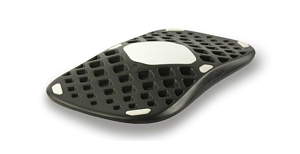
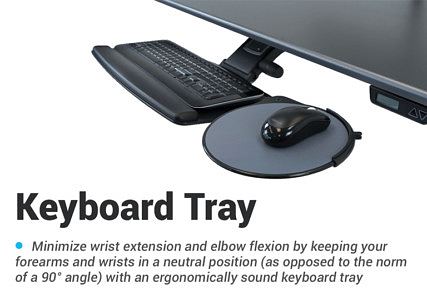
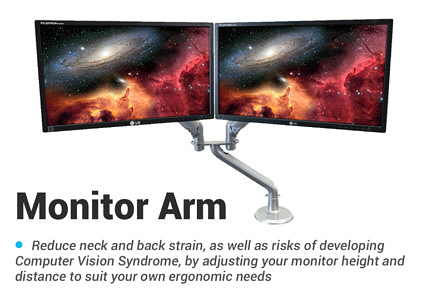
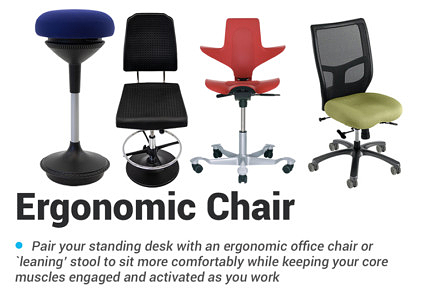
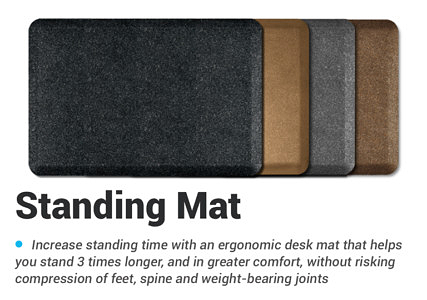
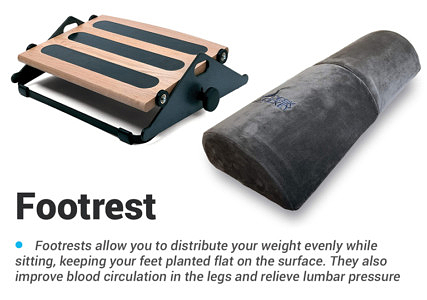
2 Comments
Leave a response >